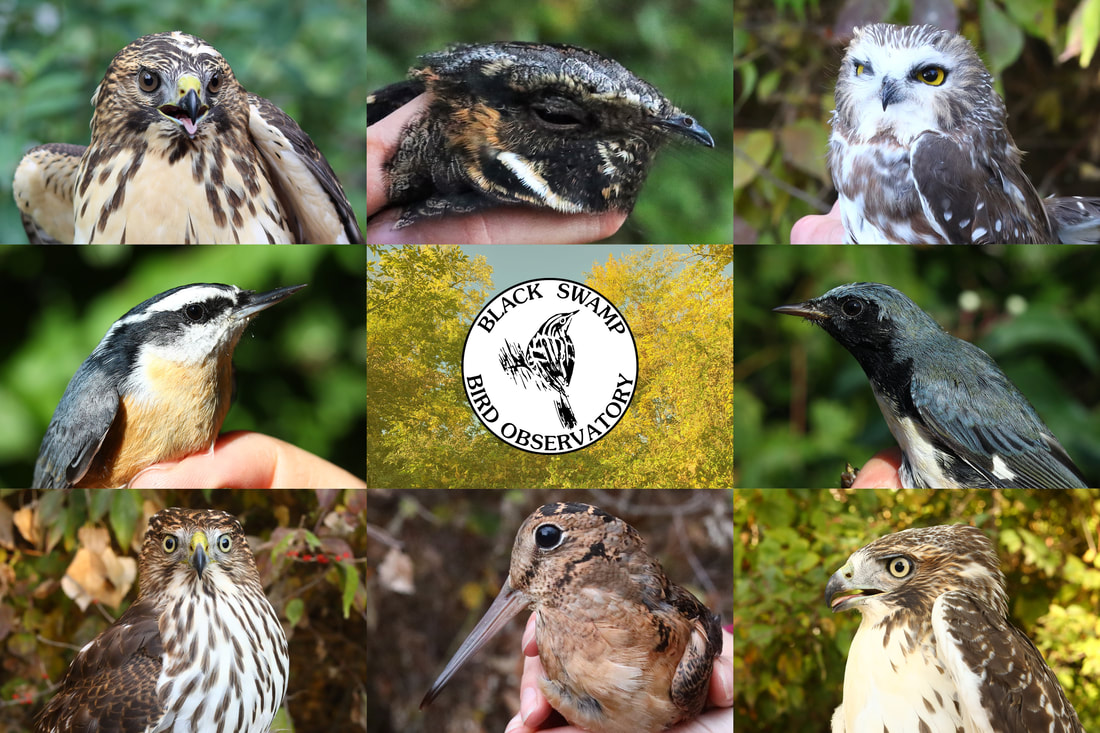Enjoying our blogs?Your support helps BSBO continue to develop and deliver educational content throughout the year.
|
|
Every season of banding is interesting in its own way. Some years it's really wet, some very hot. Sometimes the winds are perfect, and other times the wind just won't cooperate. And then some years particular species or families are prolific, and then other years all of migration is ho-hum. This was one of those falls where temperatures seemed to stay a bit warmer than usual and winds tended to be out of the south (probably explaining much of the warmer conditions). By the end of the season we ended up banding close to 5,000 birds, which is just above the long-term average for fall (4,780). But most of the action didn't occur until October once short-distance migrants began moving through the region. In fact, we didn't have a 100 bird day until September 27th (one of the latest years to go without a 100 bird day) with the rest of our 100 bird days occurring in October (we never did break a 200 bird day this fall). Owing to this slow start was the lack of long-distance migrants, particularly Blackpoll Warbler, Swainson's Thrush, Gray-cheeked Thrush, and many of the warblers. For many of these long-distance migrants, they weren't significantly below average (except maybe Blackpoll Warbler and Gray-cheeked Thrush), but on the whole, the below average numbers in many of these species made for a slow September. Of special note though were Black-throated Blue Warbler who set a new high record for fall and were 138% above the long-term average. If there had been just a few less Gray-cheeked Thrush, Black-throated Blue Warbler would have cracked the top ten species banded for the first time ever. What led to this influx of Black-throated Blues when nearly all the other long-distance warblers were below average is so interesting to ponder. Was this a regional influx or range-wide? How will this carry over into spring next year? Will we see a dip next year? As alluded to earlier, much of this season's numbers came during October (over half of all this fall's birds were banded in October). Leading the way in October were White-throated Sparrow, Golden-crowned and Ruby-crowned Kinglet, Myrtle Warbler, and Hermit Thrush. Unlike other years, we never really saw a big push of these short-distance migrants on a particular day. In many years, we will get close to 100 (or more) kinglets on a given a day, or White-throated Sparrows, and then they'll peter out after this. Instead, throughout October we would have consistent days of a couple dozen or more of these species. Rather than big pushes, we experienced a steady stream of these short-distance migrants throughout October, leading to many of them being above average. The other very interesting part of this fall was the number of "big" birds encountered. Before the season gained traction in October, we joked that it was the season for big birds. And whoa was it! We banded the first ever Broad-winged Hawk for the station; the fifth ever Red-tailed Hawk for fall; the sixth ever Cooper's Hawk for fall; the third and fourth ever Northern Saw-whet Owls for fall; the second ever Eastern Whip-poor-will for fall; AND... 14 American Woodcock (24% of all the woodcocks we've ever banded in fall were banded this season). While we hoped to continue this trend with a random Red-shouldered Hawk or Northern Shrike (which never came to pass) it was still an incredible season for these non-target species. While there is much work ahead now on data entry, presented here is a preliminary breakdown of some of the numbers from this season: Total Birds Banded: 4,846 (1% above average) Species Banded: 90 Banding Days: 72 Banding Hours: 321.61 Number of Volunteers: 38 Species with New High Records: American Woodcock - 14 Broad-winged Hawk - 1 Northern Saw-whet Owl - 2 Black-billed Cuckoo - 2 Slate-colored Junco - 81 Black-throated Blue Warbler - 112 White-breasted Nuthatch - 7 American Robin - 219 Top Ten Species Banded with % Difference from 1990-2021 Average (green above, red below): White-throated Sparrow - 572 67% Swainson's Thrush - 392 19% Golden-crowned Kinglet - 380 49% Blackpoll Warbler - 374 33% Gray Catbird - 323 11% Myrtle Warbler - 319 9% Hermit Thrush - 273 50% Ruby-crowned Kinglet - 260 28% American Robin - 219 217% Gray-cheeked Thrush - 123 31% For more numbers throughout the season, head over to the 2022 Fall Daily Banding Totals on our Passerine Research Page.
We would like to thank our incredible, dedicated group of volunteers and seasonal techs that put all their effort into ensuring a successful banding operation; for both data quality and bird safety. We couldn't do it without all your support!!! We would also like to thank the amazing crew at Ottawa National Wildlife Refuge for their continued support of this project (both in research and housing for techs) and Davis–Besse Nuclear Power Station and Energy Harbor for preserving and allowing access to this incredible habitat. If you would like to support BSBO's research efforts, please consider our Sponsor a Mist Net program, which directly contributes to our banding programs. Learn more and Sponsor a Mist Net here.
0 Comments
|
AuthorsRyan Jacob, Ashli Gorbet, Mark Shieldcastle ABOUT THE
|
